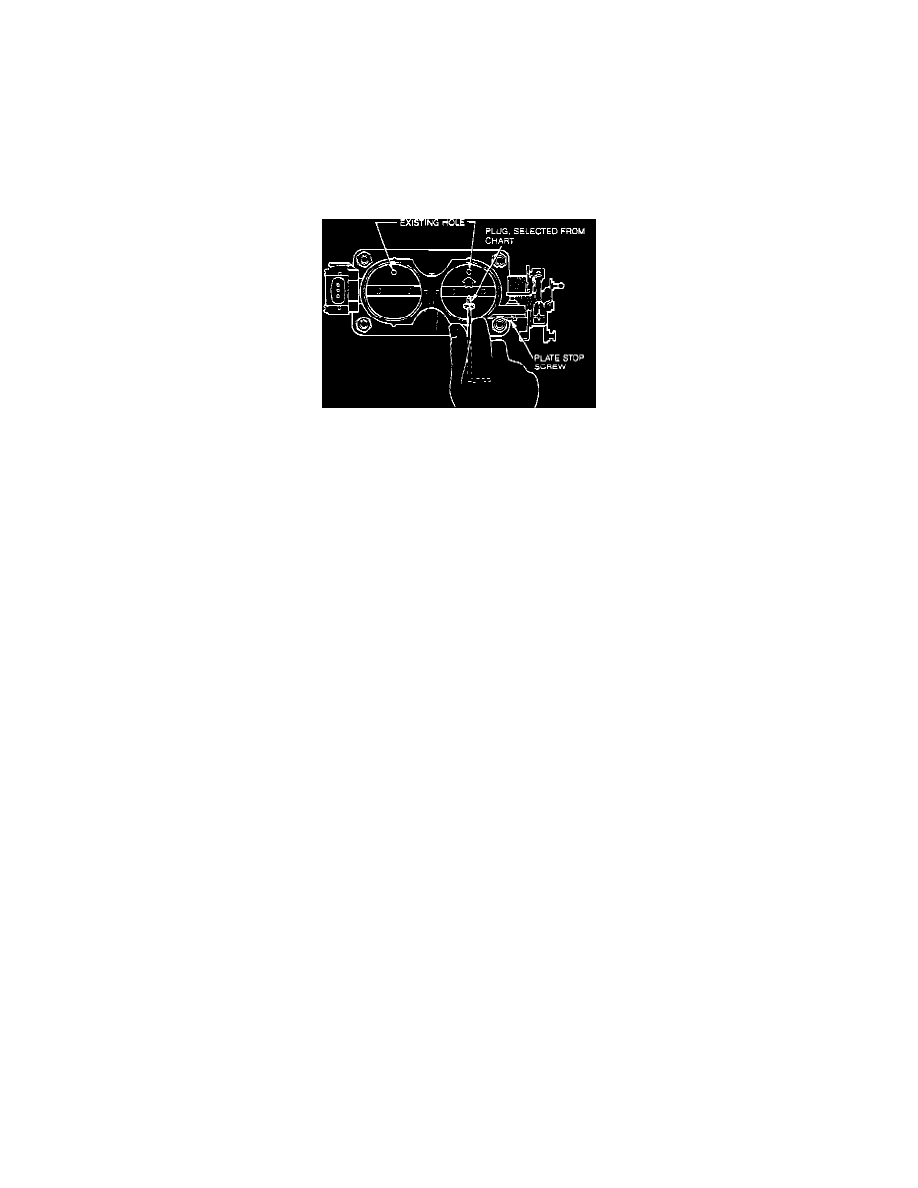Tempo V6-182 3.0L (1993)

A single pulse code indicates the entry mode, then observe the Self-Test Output (STO) of the scan tool in Step 4. If adjustment is required in Step
4, ensure all other causes have been addressed and corrected before continuing.
STEP 4
a. A constant tone, solid light or "STO LO" readout means base idle rpm is within range. To exit test, unlatch STI button, then wait 4 seconds for
reinitialization (after 10 minutes it will exit by itself).
b. Beeping tone, flashing light, or "STO LO" readout at (8 Hz) indicates Throttle Position Sensor is out of range due to over adjustment;
adjustment may be required.
c. Beeping tone, flashing light, or "STO LO" readout at (4 Hz) indicates base idle rpm is too fast, adjustment is required, go to Step 6.
d. Beeping tone, flashing light, or "STO LO" readout at (1 Hz) indicates base idle is too low, adjustment is required, go to Step 5.
Throttle Plate Orifice Plug
STEP 5 - Rpm Too Low
DO NOT clean the throttle body. Check for throttle plate orifice plug.
-
No plug found, turn throttle stop screw clockwise until conditions in Step 4a are satisfied.
-
Plug is present from previous service, remove and adjust throttle stop screw in either direction as required.
NOTE: Throttle stop screw must be in contact with the lever pad after adjustment.
STEP 6 - Rpm Too High
a. Turn "Off" engine.
b. Block orifice on the throttle plate temporarily with tape. If the orifice already has a plug from previous service, go to Step (d), otherwise
proceed with next step.
c
REStart engine and check idle speed using Self-Test. If engine stalls, crack open throttle plate with the throttle plate stop screw.
NOTE: Mass Airflow models require the air intake hose to be reattached first.
d. If rpm continues to be fast, perform Key On Engine Off (KOEO) self-test for proper Throttle Position (TP) sensor DTC.
-
If TP sensor output code is within range, remove tape and Go To Diagnostic Routines for other causes.
-
If TP sensor is out of range, adjust screw for proper TP sensor code (lever pad must be in contact with throttle stop screw after
adjustment).
-
If rpm is still fast, terminate this procedure and Go To Diagnostic Routines for other causes.
e. If rpm drops to or below desired level indicated by Self-Test Output tone, turn engine "Off", disconnect air cleaner hose and remove tape.
f.
Install orifice plug with proper color code depending on throttle plate orifice size (Refer to PROCEDURES FOR THROTTLE PLATE
ORIFICE PLUG INSTALLATION, below).
g. Reconnect air cleaner hose. "Start" engine, and turn throttle plate stop screw clockwise (DO NOT turn it counterclockwise as this may cause
the throttle to stick at idle) until the conditions in Step 4a are satisfied.
STEP 7
Run the KOEO Self-Test for proper TP sensor DTC.
STEP 8
Verify throttle plate is not sticking in bore, and linkage is not preventing the throttle from closing properly.
STEP 9
Automatic Overdrive Transmission (AOD) equipped vehicles, check Throttle Valve (TV) pressure adjustment.
THROTTLE PLATE ORIFICE PLUG INSTALLATION
1.
Remove air inlet tube(s) from throttle body.
2.
Select proper color plug by using the Go/No-Go gauge pegs, included with the service kit.
3.
Start with largest diameter gauge peg and attempt to insert it through throttle plate orifice.
-
If gauge peg goes through orifice, use corresponding colored plug.
